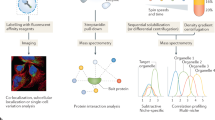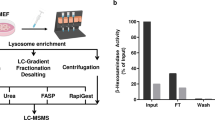Tissue subcellular fractionation and protein extraction for use in mass-spectrometry-based proteomics (original) (raw)
- Protocol
- Published: 22 November 2006
Nature Protocols volume 1, pages 1872–1878 (2006)Cite this article
- 16k Accesses
- 268 Citations
- 8 Altmetric
- Metrics details
Abstract
We have shown that sample fractionation is an effective method for increasing the detection coverage of the proteome of complex samples, such as organs, by mass-spectrometric techniques. Further fractionating a sample based on subcellular compartments can generate molecular information on the state of a tissue and the distribution of its protein components. Although many methods exist for fractionating proteins, the method described here can capture the majority of subcellular fractions simultaneously at reasonable purity. The scalability of this method makes it amenable to small samples, such as embryonic tissues, in addition to larger tissues. The protocol described is for the general fractionation and extraction of proteins from organs or tissues for subsequent analysis by mass spectrometry. It uses differential centrifugation in density gradients to isolate nuclear, cytosolic, mitochondrial and mixed microsomal (Golgi, endoplasmic reticulum, other vesicles and plasma membrane) fractions. Once the fractions are isolated, they are extracted for protein and the samples can then be frozen for processing and analysis at a later date. The procedure can typically be completed in 5 h.
This is a preview of subscription content, access via your institution
Access options
Subscribe to this journal
Receive 12 print issues and online access
$259.00 per year
only $21.58 per issue
Buy this article
- Purchase on SpringerLink
- Instant access to full article PDF
Prices may be subject to local taxes which are calculated during checkout
Additional access options:
Similar content being viewed by others

Subcellular proteomics
Article 29 April 2021


References
- Kislinger, T. et al. PRISM, a Generic Large Scale Proteomic Investigation Strategy for Mammals. Mol. Cell. Proteomics 2, 96–106 (2003).
Article CAS Google Scholar - Mootha, V.K. et al. Integrated analysis of protein composition, tissue diversity, and gene regulation in mouse mitochondria. Cell 115, 629–640 (2003).
Article CAS Google Scholar - Krapfenbauer, K., Fountoulakis, M. & Lubec, G. A rat brain protein expression map including cytosolic and enriched mitochondrial and microsomal fractions. Electrophoresis 24, 1847–1870 (2003).
Article CAS Google Scholar - Dreger, M., Bengtsson, L., Schoneberg, T., Otto, H. & Hucho, F. Nuclear envelope proteomics: novel integral membrane proteins of the inner nuclear membrane. Proc. Natl. Acad. Sci. USA 98, 11943–11948 (2001).
Article CAS Google Scholar - Kislinger, T. et al. Global survey of organ and organelle protein expression in mouse: combined proteomic and transcriptomic profiling. Cell 125, 173–186 (2006).
Article CAS Google Scholar - Hoffmann, K. et al. New application of a subcellular fractionation method to kidney and testis for the determination of conjugated linoleic acid in selected cell organelles of healthy and cancerous human tissues. Anal. Bioanal. Chem. 381, 1138–1144 (2005).
Article CAS Google Scholar - Foster, L.J. et al. A mammalian organelle map by protein correlation profiling. Cell 125, 187–199 (2006).
Article CAS Google Scholar - Reifschneider, N.H. et al. Defining the mitochondrial proteomes from five rat organs in a physiologically significant context using 2D blue-native/SDS-PAGE. J. Proteome Res. 5, 1117–1132 (2006).
Article CAS Google Scholar - Holden, M.J. & Colombini, M. The outer mitochondrial membrane channel, VDAC, is modulated by a protein localized in the intermembrane space. Biochim. Biophys. Acta 1144, 396–402 (1993).
Article CAS Google Scholar - Bradford, M.M. A rapid and sensitive method for the quantitation of microgram quantities of protein utilizing the principle of protein-dye binding. Anal. Biochem. 72, 248–254 (1976).
Article CAS Google Scholar
Acknowledgements
The authors would like to thank Dr. Thomas Kislinger for assistance in development of this protocol and the reviewers for their thoughtful comments on the protocol. Operating grants were awarded to A.E. from the McLaughlin Centre for Molecular Medicine, Genome Canada, the Ontario Genomics Institute (OGI) and the National Science and Engineering Council of Canada (NSERC). B.C. was supported by a Canadian Institutes of Health Research Doctoral fellowship.
Author information
Authors and Affiliations
- Department of Medical Genetics, 1 King's College Circle, University of Toronto, Toronto, M5S 1A8, ON, Canada
Brian Cox & Andrew Emili - Department of Developmental and Stem Cell Biology, The Hospital for Sick Children Research Institute, 101 College Street, Toronto, M5G 1L7, ON, Canada
Brian Cox - Banting and Best Department of Medical Research, University of Toronto, 112 College Street, Toronto, M5G 1L6, ON, Canada
Andrew Emili - Donnely Centre for Cellular and Biomedical Research, University of Toronto, 160 College Street, Toronto, M5S 3E1, ON, Canada
Andrew Emili
Authors
- Brian Cox
You can also search for this author inPubMed Google Scholar - Andrew Emili
You can also search for this author inPubMed Google Scholar
Corresponding author
Correspondence toBrian Cox.
Ethics declarations
Competing interests
The authors declare no competing financial interests.
Rights and permissions
About this article
Cite this article
Cox, B., Emili, A. Tissue subcellular fractionation and protein extraction for use in mass-spectrometry-based proteomics.Nat Protoc 1, 1872–1878 (2006). https://doi.org/10.1038/nprot.2006.273
- Published: 22 November 2006
- Issue Date: November 2006
- DOI: https://doi.org/10.1038/nprot.2006.273